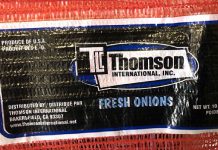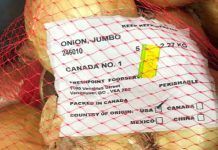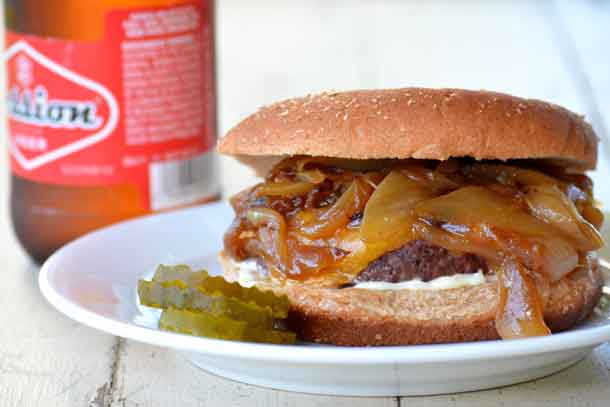
THUNDER BAY – (Zester Daily) – At a time of year when most people are fixated on berries and peaches, corn and tomatoes, it’s also the season to get excited about onions — not just any old allium but a heritage sweet onion harvested by hand in Walla Walla, Washington.
Walla Walla Sweets are the unheralded heirloom stars of summertime. Juicy, mild and sweet, they are at their best in all of the great (and easy) meals of the season: grilled with sausages, caramelized for burgers, sliced raw for salads and more.
Fresh and delicate in terms of both flavor and handling, Walla Walla Sweets are in season right now — and with a very limited supply from a handful of family growers, they won’t last long.
Older than Vidalias
Long before Walla Walla became renowned as an American Viticultural Area, this valley in southeastern Washington was the agricultural hub for a surprisingly sweet onion brought to the region from Corsica by a French soldier named Pete Pieri. According to all accounts, Pieri immigrated to Walla Walla with the seed in the late 19th century and began cultivating it commercially in 1900.
Grower Michael Locati’s great-grandfather, Joe, worked for Pieri for four years before going out on his own in 1909. He joined other Italian immigrant families, mainly from Milan and Calabria, who settled in this valley to become small-scale produce farmers, cultivating a seasonal onion now known as the Walla Walla Sweet.
Four generations later, Michael — along with his father and uncle — grows these heirlooms on 60 acres of Locati Farms and co-owns a packing and shipping arm called Walla Walla River Packing Co. Despite these modernizations, this is the same specialty onion, hand-selected by the family for over a century.
That’s a fair bit longer than that other famous sweet onion, Vidalia, a hybrid cultivated in Georgia since the 1930s. The Walla Walla “still has that heirloom genome,” said Locati.
Onion botany
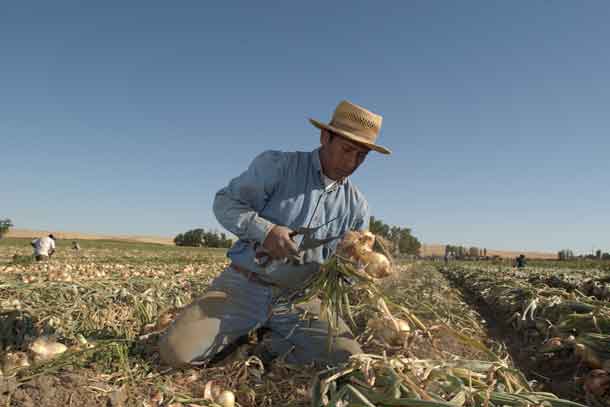
It’s natural to think that sugar content is what makes Walla Walla Sweets exceptional. Not so. Their mildness has to do with the fact that they contain about half the amount of pyruvic acid that gives yellow storage onions their bite and makes you cry.
“This geographical area is very low in natural sulfur,” Locati said. The sulfur content in the soil is a catalyst to the production of pyruvic acid, he explained. “So these naturally low sulfur soils allow for these onions to be really sweet.”
Walla Walla Sweets are planted in early fall. They overwinter in snow-covered fields, then sprout and additional onion starts are transplanted in the spring. By mid-June, harvest has begun and continues through late August.
“Onions are ready when the leaves start laying down,” said Dan McClure, who began growing organic Walla Walla Sweets in 2007 with his wife Sarah. The couple currently raises over 800 tons on 27 acres at Walla Walla Organics and plans to scale up production, although the labor is even more arduous than many other crops.
Why’s that?
“No mechanical process yet exists that won’t damage them,” McClure said. Nearly as large as softballs and weighing up to two pounds, these globular onions are delicate, with thin skins and a high water content that make them prone to bruising.
So workers harvest them entirely by hand. Carefully packed into boxes, the onions are then cured just until the necks dry out and the outer layer of turns amber. Still, they have a short shelf life — a couple of weeks at most, according to McClure.
Endangered onions?
For a community once famous for this varietal, it’s a big blow that acreage has dropped within the past five or so years from 1,000 acres to about 500, according to Kathryn Fry-Trommald, executive director of the Walla Walla Sweet Onion Marketing Committee.
Compared to Vidalia’s 15,000 acres, this onion market is small potatoes. Urban sprawl (“there’s a Wal-mart now where there were onion fields,” said Fry-Trommald), consolidation in agriculture and labor pressures are all factors, as is the fact that many of those “old Italian families” are no longer in farming.
Another major threat is the competition from hybrid sweet onions — some mechanically harvested and higher in pyruvic acid — grown from Arizona to Texas. These are available year-round at much lower prices than Walla Walla Sweets.
In 1995, after discovering that other Washington-grown onions were being sold as counterfeit Walla Walla Sweets, the growers obtained a federal marketing order to protect this specialty onion, in the same way that heritage foods from Italy must be certified as locally grown and packaged.
For farmers like Locati and McClure, it’s hard to earn a living with a seasonal, fresh market onion. But they say the process of hand selection and hand harvesting is worth it for the allium’s singular qualities. There’s no sharp bite, and it has a complex flavor all its own marked by a startling sweetness.
While you don’t have to try Michael Locati’s method of tasting them raw in the field, this is a true “slicer” for using raw in salads and salsas or on burgers and sandwiches. You can grill, roast, sauté, or caramelize Walla Walla Sweets, too — just don’t wait.
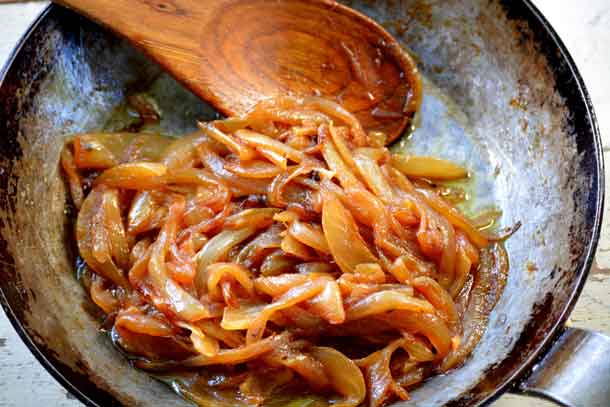
Ways to cook and use sweet onions
Grill: Use a grill basket to cook large sliced or chopped onions on a hot grill until nicely charred. Toss and continue grilling until softened and translucent. Alternatively, grill thick onion slices on a well-scraped grill grate until grill marks appear; flip and cook the other side until soft and translucent. Toss onions with sliced and grilled zucchini, portabello mushrooms and red peppers seasoned with salt and pepper, a splash of olive oil and balsamic vinegar for a side dish with grilled steaks, chicken, pork chops or fish.
Roast: Place trimmed and peeled whole onions into a greased roasting pan. Rub well with olive oil and season with salt, pepper and fresh thyme. Roast at 425 F until brown and fork tender, about 1 hour, and serve with roast pork or beef.
Sauté: Slice peeled onions thinly. Heat a sauté pan over high heat with 1 tablespoon olive oil. Add the onions and season with a pinch of salt. Cook, stirring, until they soften and begin to brown. Add 1 bunch fresh, washed spinach or chard, another pinch of salt and ground pepper. Cover and let steam until the greens are wilted. Remove the cover, stir well and serve as a side dish with grilled meats or fish.
Caramelize: Slice peeled onions thinly. Heat a sauté pan over medium-high heat with 1 tablespoon olive oil. Add the onions and cook, stirring, until they soften. Add a large pinch of salt, reduce the heat to low and continue cooking, stirring and scraping the bottom of the pan every 15 minutes until the onions turn very soft, like jam, and the color of brown sugar, about 1 hour. Serve on hamburgers, grilled cheese sandwiches or pizza.
Copyright 2016 Lynne Curry via Zester Daily and Reuters Media Express

